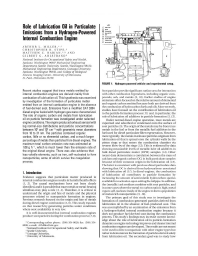 |
Recent studies suggest that trace metals emitted by internal combustion engines are derived mainly from combustion of lubrication oil. This hypothesis was examined by investigation of the formation of particulate matter emitted from an internal combustion engine in the absence of fuel-derived soot. Emissions from a modified CAT 3304 diesel engine fueled with hydrogen gas were characterized. The role of organic carbon and metals from lubrication oil on particle formation was investigated under selected engine conditions. The engine produced exhaust aerosol with log normal-size distributions and particle concentrations between 105 and 107 cm-3 with geometric mean diameters from 18 to 31 nm. The particles contained organic carbon, little or no elemental carbon, and a much larger percentage of metals than particles from diesel engines. The maximum total carbon emission rate was estimated at 1.08 g h-1, which is much lower than the emission rate of the original diesel engine. There was also evidence that less volatile elements, such as iron, self-nucleated to form nanoparticles, some of which survive the coagulation process.
| Author(s): | Miller-AL, Stipe-CB, Habjan-MC, Ahlstrand-GG |
| Reference: | Environ Sci Technol 2007 Oct; 41(19):6828-6835 |
roloi (PDF, 503 KB)
